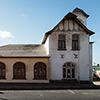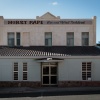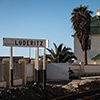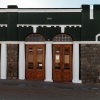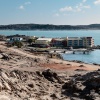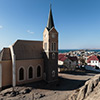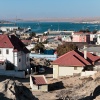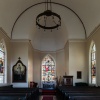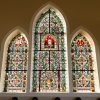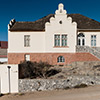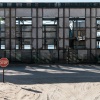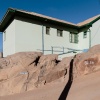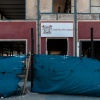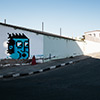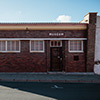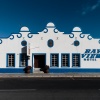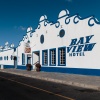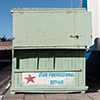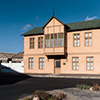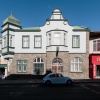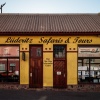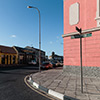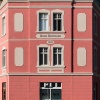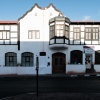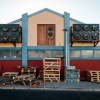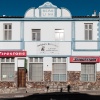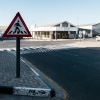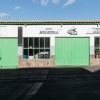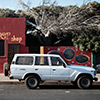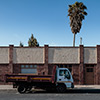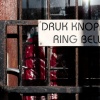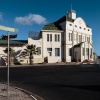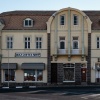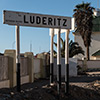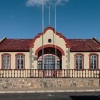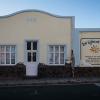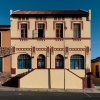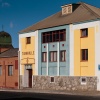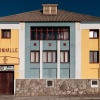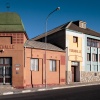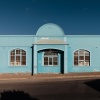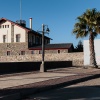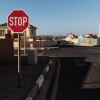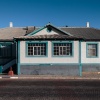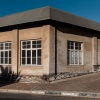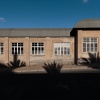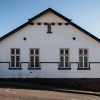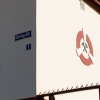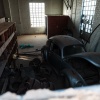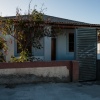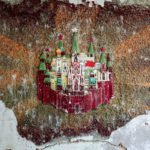Lüderitz – Germany at the Edge of Namib Desert
A city in the middle of nowhere, being surrounded by millions of tons of desert sand and directly at the shore of the Atlantic. A city that braving the elements preserves the architectonic heritage of the Wilhelmine era and standing for world-class oysters. All that is Lüderitz, located at the ocean on Namibia’s west coast.
German colonial remnant of Wilhelmine archictecture
It is evening and the sun hovers low above the Bay of Lüderitz, a natural harbour. The strong west wind takes fine spray of seawater on a journey right into my face. Its tiny drops make my lips taste like the Atlantic as I stand on the highest elevation of the settlement having the Angra Pequena at its feet, the “Small Bay”, like named by discoverer Bartolomeu Dias back in 1487. From up here one overlooks not only the roofs of cute houses, but can also spot the harbour as well as countless oyster banks, the farms for seafood having a worldwide highly acclaimed quality.
Next to me stands the Lutheran church of the community being inhabited by some 12.000 people. Means, Lüderitz is as big as my Rüdersdorf. Our fame and wealth originates from lime stone as we Rüdersdorfer built up Berlin after the war. Lüderitz’ history shows a similarity as in the southern triangle spanning between Aus and Oranjemund a resource was found being so precious that even today normal people are not allowed to enter the area: diamonds! Those shiny gemstones meant wealth for the whole region and even today trucks with unknown load rush over the only road connecting Namibia’s west coast with the inland, that is the B4, that constantly has to be cleared from the desert’s drifting sand.
Actually I came to shoot the once richest town of Africa, the meanwhile abandoned Kolmanskop that gets reconquered slowly by the desert. I still have to sort, process and put those photos online. Before heading I need a permission and stop off at Lüderitz where time seemed to have stood still as architecture, signposts and street names pretty much remind of the Wilhelmine era of colonial German South-West Africa. Skyscrapers are an alien concept over here making the Rock Church being the tallest one around. Like any other Evangelic-Lutheran church it is not pretty much embellished inside. A few coloured windows – the altar window is a personal gift of Emperor Wilhelm II – plus a functional chandelier, that’s it. Sitting down the wooden benches make you instantly feel all bones, however, the local cleric seems to be adapted as profoundly snoring he’s having a peaceful nap.
When the Germans arrived in the person of Bremen tobacco merchant Adolf Lüderitz and companion Heinrich Vogelsang back in 1883 they didn’t have the merest clue about finding diamonds. Also the discoverers (Portuguese) and the regional power (English) didn’t really care about this piece of later German South-West Africa. Lüderitz and his partner scammed the locals to get hold of the land, something that went down in history as Mile Swindle. Successively they developed the bay into an important commercial centre that got officially part of the German colony in 1884.
Around the turn-of-the-century, when a railroad got built to connect Lüderitz with the rest of the country, diamond deposits got discovered. That find kicked off a boom that didn’t fail to leave its mark on Lüderitz as well. At the outbreak of WWII South African troops instantly conquered the whole diamond area without fighting; an uncontestedly snatched treasure South Africa can live off even today and even if it’s on Namibian territory as after Namibia’s independence from South Africa the De Beers group entered NamDeb’s business.
Lüderitz’ urban development tells the story of those golden times and despite charging western winds and the ever corrosive force of salt water that’s normally eating away everything, the town appears as if the guys around Adolf Lüderitz moved out yesterday. Part of this city is Rainer who runs Element Riders and lives the Namibian dream. If you have no clue about this dream then give him a visit to look in his cheerful and energy sparkling eyes after having returned from his regular evening surf. Then you quickly notice that you can find an authentic piece of personal luck even at the end of the world in town surrounded by 100 kilometres of desert.
The light of the descending austral sun boosts the evening walk through the city as it teases out vigorous colours as well as bold contrasts. Despite being built in a forbidding landscape, on sparse rocks surrounded by millions of tons of sand, Lüderitz is a quite colourful city. Bringing the day to an end at the harbour, with a wonderful evening view of city and ocean while enjoying fresh or grilled oysters accompanied by a South African Chenin blanc wine, well, that’s one of those moments set in stone in my memories.
At that part of the world the Atlantic Ocean is pretty much the opposite of the desert as scorching heat clashes with ball-freezing cold water. In an oceanic context that means an abundant food supply though, for example for one of the most northern living penguin colonies in the world. It is that freshness, that kind of minerally tasting flavour of the ocean, that Lüderitz oysters are able to transport right on your gums; a wow-feeling coming directly from the farmer for very few money.

